I’ve tried many, many variations of vegetarian chili over the years, but this Slow Cooker 3-Bean Chili is really the very best. With three kinds of beans for heft, tangy tomatoes, full-of-flavor spices, and just the right touch of heat, this slow cooker vegetarian chili delivers.
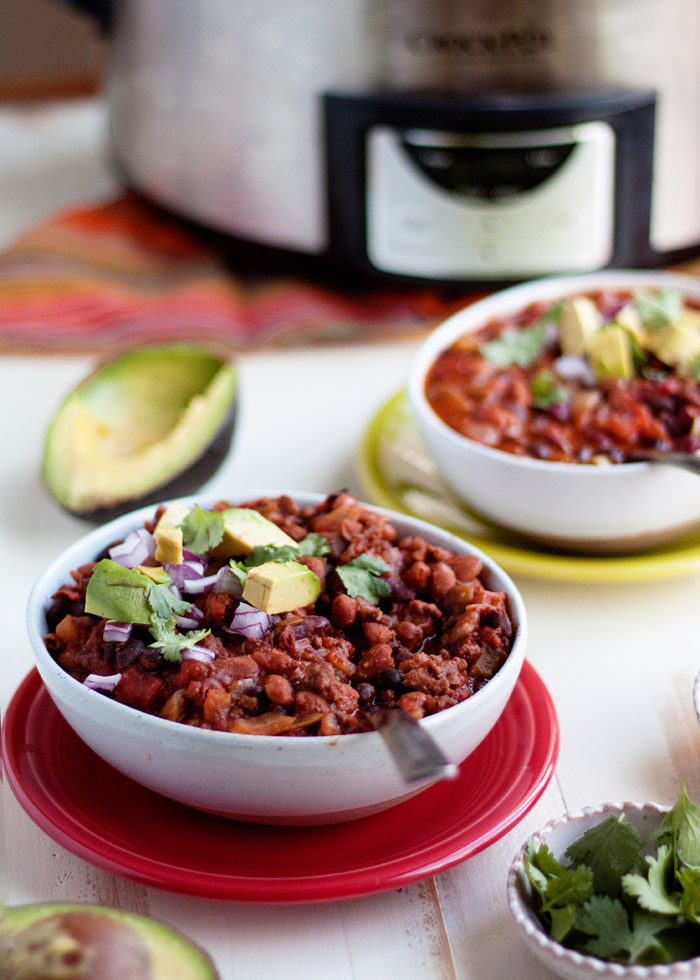
I tried super simple chili, chili with a gazillion ingredients, chili with “secret ingredients” like unsweetened cocoa or brewed coffee (both very good, actually) … but this 3 bean chili – slow cooker style – rules them all.
Table of Contents
- The Story Behind the Recipe
- Why You’ll Love 3-Bean Chili Slow Cooker
- Crock Pot 3-Bean Chili Ingredients
- More Crock Pot chili recipes
The Story Behind the Recipe
This slow cooker 3-bean chili recipe is the one that’s been floating around on a piece of paper with the title of “THE Chili.” My guy took a bite of his version (with meat, option for carnivores is in the recipe) and said, “This is it. You can stop at this one. It’s perfect.”
I feel the same way about the vegetarian/vegan version.
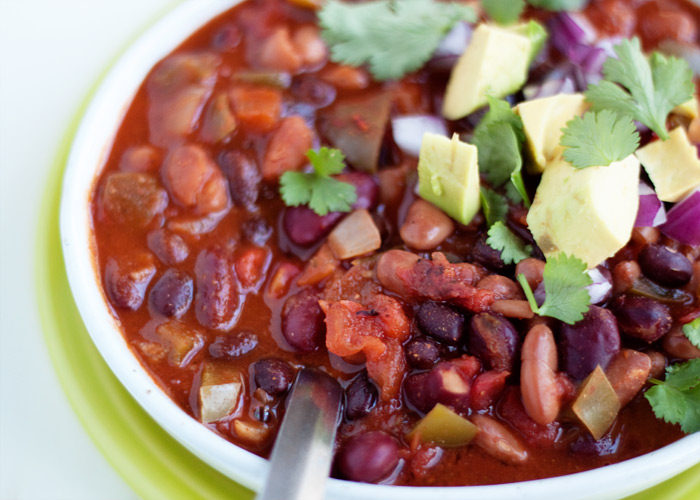
Why You’ll Love 3-Bean Chili Slow Cooker
Readers say …
– Olivia
I’ve made this recipe both ways and it’s really versatile and delicious even when you don’t have all the ingredients or substitute anything. This is the recipe I send to everyone that asks how I make my chili.
This recipe is simple! This Slow-Cooker 3-Bean Chili is super simple to throw together, and takes next to no work to cook. It bubbles in the Crock Pot all day, simmering to dinnertime perfection.
It’s versatile too. You can stick with the vegetarian chili, or if you want it one-dish-two-ways style, just brown some ground beef, simmer some of the chili together with the meat for a bit, and dinner’s ready.
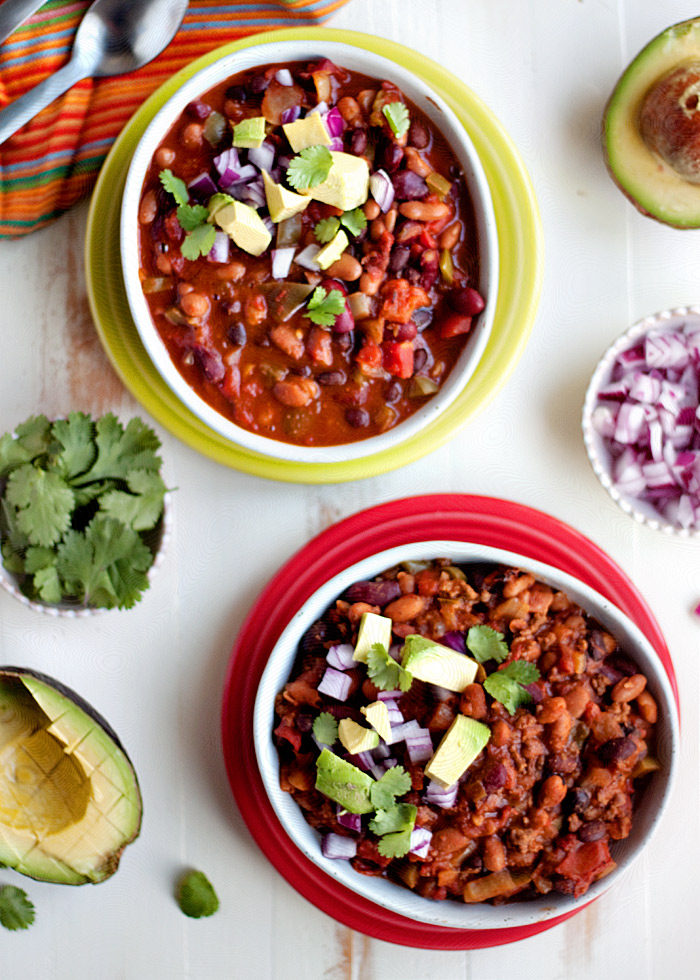
Crock Pot 3-Bean Chili Ingredients
As-is without the Tabasco, this is a nice, mild, family-friendly chili – not much heat at all. Add the Tabasco at the end, offer it up as a topping, or omit it altogether, depending on your preferences.
- Chili beans in sauce – I like using chili beans in sauce for an added boost of flavor.
- Black beans – love black beans in chili!
- Kidney beans – larger than chili beans or black beans for hearty bites of chili.
- Fire-roasted diced tomatoes – I really like fire-roasted tomatoes for the added smoky bit of flavor.
- Onions, green peppers, and garlic – Aromatic veggies that make this vegetarian chili sing!
- Chili powder, cumin, and oregano – Classic chili spices; a must! Use a milder chili powder if you’re not wanting much heat, or a hotter chili powder if you like it spicy.
- Tabasco sauce (optional) – A finish with a few dashes of Tabasco makes this chili extra good!
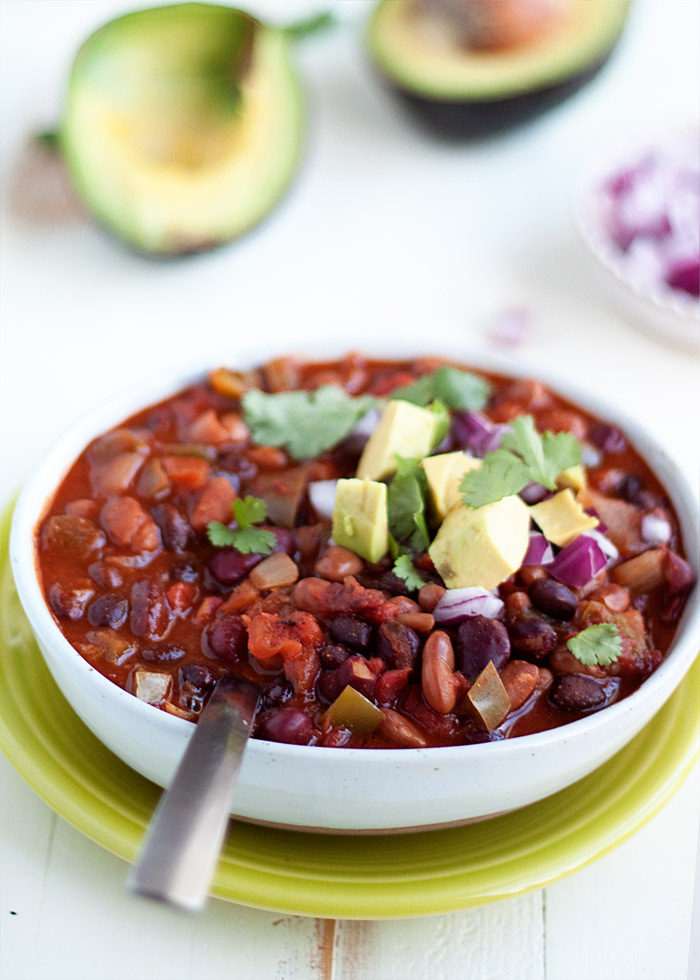
More Crock Pot chili recipes
- Slow Cooker Butternut Squash Coconut Chili from The Fig Tree
- Crock Pot Pumpkin Red Lentil Chili from moi!
- Lentil Chili with Roasted Red Peppers, Olives, and Green Onion from Kalyn’s Kitchen
- Slow Cooker Black Bean & Mango Caribbean Chili from me!
- Slow Cooker 3-Bean Winter Chili from Boulder Locavore
- 17 Crock Pot Vegetarian Chili Recipes (+ 4 bonus meaty chili recipes for the carnivores)
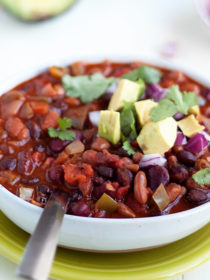
Slow-Cooker 3-Bean Chili
Ingredients
- 30 ounces chili beans in sauce (2 [15-ounce] cans)
- 15 ounces kidney beans, drained (1 [15-ounce] can)
- 15 ounces black beans, drained (1 [15-ounce] can)
- 30 ounces fire-roasted diced tomatoes (2 [15-ounce] cans; crushed tomatoes are also good)
- 2 medium green peppers (diced [about 3 cups])
- 2 medium yellow onions (diced [about 3 cups])
- 2 medium cloves garlic (minced)
- 2 tablespoons chili powder*
- 1 tablespoon ground cumin
- 1 teaspoon dried oregano
- 20 dashes Tabasco sauce (optional)
Instructions
- Add all ingredients except the Tabasco (if using) and the ground beef to the slow-cooker/Crock Pot. Stir. Cook on low for 8 – 10 hours or on high for 5-6 hours. Taste and add Tabasco if desired. If serving an all-vegan chili, skip to “Serve with toppings.”
- Serve with assorted toppings such as diced avocado, fresh cilantro, chopped onions, sour cream (or vegan sour cream), grated cheddar or jack cheese (or vegan cheese), and some Tabasco or Tapatio sauce.


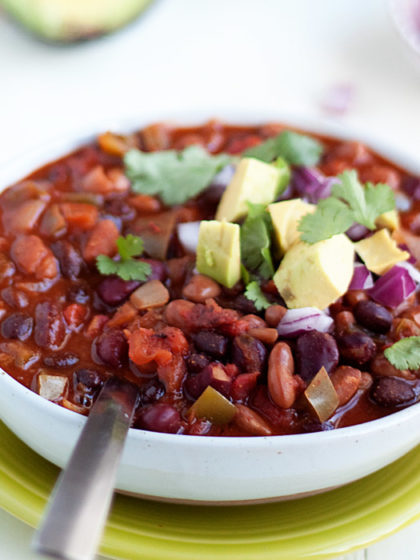
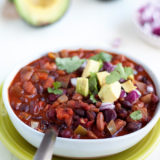
 I’m so glad you’re here! I’m a vegetarian home cook, certified plant-based pro, and mom. I’m married to an enthusiastic carnivore, and my mission is to achieve peace in the kitchen – one tasty recipe at a time. These days, with a name like mine, I also try not to ask to speak to the manager.
I’m so glad you’re here! I’m a vegetarian home cook, certified plant-based pro, and mom. I’m married to an enthusiastic carnivore, and my mission is to achieve peace in the kitchen – one tasty recipe at a time. These days, with a name like mine, I also try not to ask to speak to the manager.
This sounds DELISH! I need to pick up some fire roasted tomatoes and give this a try~
Pingback: 17 Crock Pot Vegetarian Chili Recipes (+ 5 Bonus Meaty Chili Recipes for the Carnivores) | Kitchen Treaty
Made this recipe and got rave reviews from my daughter’s basketball coaches and team. I made one minor modification because I did not have all the ingredients. I substituted one can of roasted tomatoes, 1 medium onion, and tabasco sauce with one 16-ounce jar of Herdez Casera salsa. Thank you for posting!
So glad you (and everyone) liked it! Great idea to add the salsa. 🙂
What if I added some cubes of steak at the beginning?
I’m sure that would be great! I’ve not made it that way, but it’s a very versatile chili. I’d think it’d be nice if you quickly browned the steak with a little salt and pepper before you put it in the Crock Pot with everything else. If you try it please come back and let us know how it turned out!
Was fantastic! I made it tonight and I used Boca Crumbles, and used Siracha Sauce instead of Tabasco.
So glad you liked it! Great idea using sriracha for an added bit of heat – love it. 🙂
Can’t wait to make this! Do you think I could cook it on high for 4 hours in a pinch?
The recipe calls for 2 cans of chili in sauce. So is this already made chili beans like Nalley’s chili or chili beans that are not drained?
Hi Connie, it is chili beans that actually come in a sauce! So it’s not a canned chili or just plain beans. But honestly, you could just use a couple of cans of drained beans and it would still be good! 🙂
Thank you so much Karen I really appreciate the help. I’m going to make this tomorrow along with some cornbread, yum!!
Pingback: 21 Crockpot Chili Recipes
I’m getting this ready for the crockpot now to serve for 40 tomorrow. Does it not require extra liquid? I’m a novice crockpot user, but it seems like most recipes add water? Thank you!
Hi Jeni, no extra liquid needed! Slow cooker recipes require much less liquid because it doesn’t evaporate.
I love how bright and vibrant this chili is!
This is exactly what I was searching for. I have to make chili for vegan and meat eaters and I wanted a slow cooker version of it so I can start it tonight. I may put a little red wine in this (I’ve made beef chili before with red wine or beer added). Then I am going to try to add some sauteed ground beef and maybe some sausage to half of it around a half hour or so before serving. I’ll let you know how it turns out.
So good! Ive been looking for the perfect chili and this is it! I’m confused about the 3 beans though. Are chili beans not kidney beans?
Oh, I did use crushed tomatoes instead and about 10 splashes of cholula instead of Tabasco sauce. Perfection!
I’m so glad you like it! To my knowledge chili beans are a smaller red bean. 🙂
Can I completely double the recipe to feed a larger crowd?
Absolutely!
What size is your slow cooker?
Its a 5 qt cooker.
Excellent, versatile recipe! I wondered at there being no added salt or pepper in the recipe, then read the fire roast tomatoes can label and realized it was already in. No lack of flavour here!
Added a soy ground beef replacement at the end and roasted peppers we had in the freezer with good results as well.
Thanks!
Thanks Debbie! 🙂
Very tasty. No meat required. Full disclosure: I tried adding a little ground chipotle peppers, which was okay but probably not necessary. Also, the chili turned out just a bit thin, so maybe I was supposed to drain the tomatoes. I don’t know. Regardless, it was great and I will make it again. Thank you for sharing!
Pingback: Slow Cooker Easy Three Bean Chili with Ground Beef (or not) from Kitchen Treaty - Slow Cooker or Pressure Cooker
I made this chili today, and it was awesome! Thanks so much for sharing it.
Pingback: The BEST Slow Cooker Chili Recipes - Slow Cooker or Pressure Cooker
Can you make this in a pressure cooker? If so, at what pressure and for how long?
Delicious and so easy to make. I served it over brown rice with cornbread muffins. Also nice you can freeze it.
Thank you so much for this recipe. My 8 year old decided to be a vegetarian and we needed a recipe that she would eat. She and the rest of us love to eat this.
Thanks again
Authentic Southwestern Chili has NO BEANS of any kind !!! Never !!!
The first recipe for chili con carne was put on paper in the 17th century by a nun, Sister Mary of Agreda of Spain. She was mysteriously known to the Indians of the Southwest United States as “La Dama de Azul,” the lady in blue. It is said that Sister Mary wrote down the recipe for chili which called for venison or antelope meat, onions, tomatoes, and chile peppers. On March 9, 1731, a group of sixteen families (56 persons) arrived from the Canary Islands at Bexar, the villa of San Fernando de Bexar, now know as the city of San Antonio. They had emigrated to Texas from the Spanish Canary Islands by order of King Philip V. of Spain.The King of Spain felt that colonization would help cement Spanish claims to the region and block France’s westward expansion from Louisiana. These families founded San Antonio’s first civil government which became the first municipality in the Spanish province of Texas. According to historians, the women of San Antonia using the recipe of Sister Mary made the spicy stew that is known as authentic Southwestern Chili.
Some Spanish priests were said to be wary of the passion inspired by chile peppers, assuming they were aphrodisiacs. A few preached sermons against indulgence in a food which they said was almost as “hot as hell’s brimstone” and “Soup of the Devil.” The priest’s warning probably contributed to the dish’s popularity. Records were found by Everrette DeGolyer (1886-1956), a Dallas millionaire and a lover of chili, indicating that the first chili mix was concocted around 1850 by Texan adventurers and cowboys as a staple for hard times when traveling to and in the California gold fields and around Texas. Needing hot grub, the trail cooks came up with a sort of stew. They pounded dried beef, fat, pepper, salt, and the chile peppers together into stackable rectangles which could be easily rehydrated with boiling water. This amounted to “brick chili” or “chili bricks” that could be boiled in pots along the trail. DeGolyer said that chili should be called
“chili a la Americano” because the term chili is generic in Mexico and simply means a hot pepper. He believed that chili con carne began as the “pemmican of the Southwest.” It is said that some trail cooks planted pepper seeds, oregano, and onions in mesquite patches (to protect them from foraging cattle) to use on future trail drives. It is thought that the chile peppers used in the earliest dishes were probably chilipiqued, which grow wild on bushes in Texas, particularly the southern part of the state. There was another group of Texans known as “Lavanderas,” or “Washerwoman,” that followed around the 19th-century armies of Texas making a stew of goat meat or venison, wild marjoram and chile peppers. – Residents of the Texas prisons in the mid to
late 1800s also lay claim to the creation of chili. They say that the Texas version of bread and water (or gruel) was a stew of the cheapest available ingredients (tough beef that was hacked fine and chiles and spices that was boiled in water to an edible
consistency). The “prisoner’s plight” became a status symbol of the Texas prisons and the inmates used to rate jails on the quality of their chili.
The Texas prison system made such good chili that freed inmates often wrote for the recipe, saying what they missed most after leaving was a really good bowl of chili.
William Gerard Tobin (1833-1884), former Texas Ranger, hotel proprietor, and an advocate of Texas-type Mexican food, negotiated with the United States government to sell canned chili to
the army and navy. In 1884, he organized a venture with the Range Canning Company at Fort McKavett, Texas to make chili from goat meat. Tobin’s death, a few days after the canning operation had started, ended further development and the venture failed.
The Texas chili went national when Texas set up a San Antonio Chili Stand at the 1893 Columbian Exposition in Chicago. Lyman T. Davis of Corsicana, Texas made chili that he sold from the back of a wagon for five cents a bowl with all the crackers you wanted. He later opened a meat market where he sold his chili in brick form, using the brand name of Lyman’s Famous Home Made Chili.
In 1921, he started to can chili in the back of his market and named it after his pet wolf, Kaiser Bill and called it Wolf Brand Chili (a picture of the wolf is still used on the label today). In 1924, Davis quit the chili business when his ranch was found to have lots of oil. He sold his operations to J. C. West and Fred Slauson, two Corsicana businessmen. To draw attention to the Wolf Brand Chili, the new owners had Model T Ford trucks with cabs shaped like chili cans and painted to resemble the Wolf Brand label. A live wolf was caged in the back of each truck. Today the company is owned by Stokley-Van Camp in Dallas,Texas.
Chili Queens:
– San Antonio was a wide-open town (a cattle town, a railroad town, and an army town) and by day a municipal food market and by night a wild and open place. An authoritative early account is provided in an article published in the July 1927 issue of Frontier Times
. In this article, Frank H. Bushick, San Antonio Commissioner of Taxation, reminisces about the Chili Queens and their origin at Military Plaza before they were moved to Market Square in 1887. According to Bushick: “The chili stand and chili queens are peculiarities, or unique institutions, of the Alamo City. They started away back there when the Spanish army camped on the plaza. They were started to feed the soldiers. Every class of people in every station of life patronized them in the old days. Some were attracted by the novelty of it, some by the cheapness. A big plate of chili with charro beans, and a tortilla on the side, cost a dime. A Mexican bootblack and a silk-hatted tourist would line up and eat side by side
unconscious or oblivious of the other.” Latino women nicknamed “Chili Queens” sold stew they called “chili” made with dried red chiles and beef from open-air stalls at the Military Plaza Mercado. They made their chili at home, loaded it onto colorful chili
wagons, and transported the wagons and chili to the plaza. They build mesquite fires on the square to keep the chili warm, lighted their wagons with colored lanterns, and squatted on the ground beside the cart, dishing out chili to customers who sat on wooden stools to eat their fiery stew. In those days, the world “chili” referred strictly to the pepper. They served a variation of simple, chile-spiked dishes (tamales, tortillas, chili con carne, and enchiladas). A night was not considered complete without a visit to one of these
In National Chili Cookoff Competion Contests , NO BEANS in the Chili !!!
If someone has Beans in the Chili then it is a automatic disqualification from
The Contest as Beans are not allowed ! Authentic Southwestern Chili has NO
Beans ! Beans are a side dish served with Cornbread.
This recipe is not a history lesson claiming exact authenticity.
You must only eat bean-less chili made with antelope and venison then, because anything else would inauthentic.
Regardless of the type of Meat one chooses to use in the making of Chili , My Point was that BEANS were not used in the Authentic Southwestern Texas Style Chili !!! EVER !!! I don’t care if one uses Possum Meat or whatever , BEANS are NOT used in Chili just like I stated in the above posting !!! Neither are Celery or Carrots or Corn !!!
Excellent recipe and base for other chili recipes. I’ve used this and made some alterations to GREAT result. And I’m sure I speak for many others here in response to Bear when I say…”I DON’T CARE!!!” Cool story bro, but I’m from the Midwest and we put beans in our chili and it’s delicious. Thanks to Kare for the original recipe and inspiration!
Haha! 😀 I’m so glad you like the recipe; thank you for the review (and the bean support!)
I selected this recipe over many others because it easily adapts to my mixed omnivore and vegetarian family needs. This a rare find. Looking forward to getting more flexible recipes from your emails.
Thanks so much, Pat!
Made this 2 ways and I loved the vegetarian version and the family loved the carnivore version. Win win!! Thanks!
Wonderful! So glad it was a win and thank you SO much for coming back to rate the recipe! 🙂
looking forward to making this! however do i add the liquid from the can beans in?
do i add the lquids in from the beans?
No, beans are drained. Thanks!
I’ve made this recipe both ways and it’s really versatile and delicious even when you don’t have all the ingredients or substitute anything. This is the recipe I send to everyone that asks how I make my chili.
Thank you
Wonderful! I’m so glad this one is a winner for you. Thank you SO much for coming back and leaving a review. 🙂